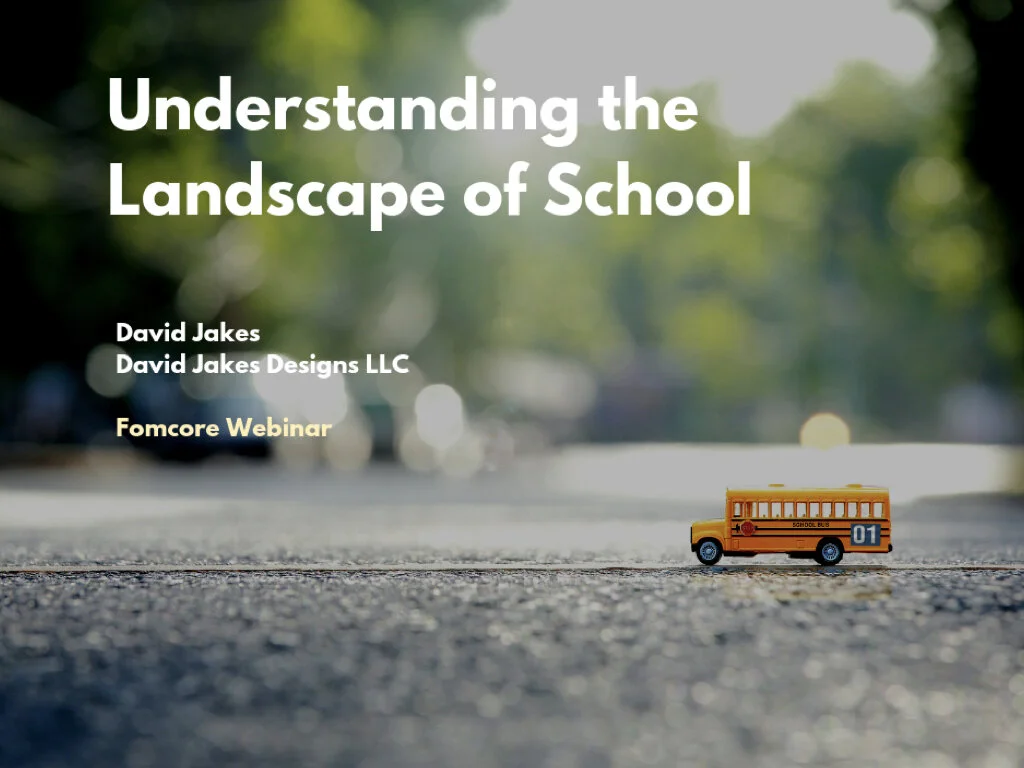Understanding the Landscape of School
Webinar Number 1 of 7
5 Key Considerations:
A Focus on an Expanded Vision of Learning | What should kids experience at school?
Could there be a focus on “Life-long, life-wide, life-deep learning,” or whole-child education, or the potential for creating launch points during school that enables students to explore their passions that lead them through the rest of their lives? How can educators create additional pathways for students to explore that lead to the skills and dispositions necessary for life opportunities not yet created yet (many that students themselves will create and not rely on formal institutions to do it for them.)
Education in the future has the opportunity to be more entrepreneurial and help students become entrepreneurial.
The upshot: school no longer can be a brick and mortar 4-wall siloed experience.
A Focus on New Dimensions in Literacy | Read Write Communicate v2.0.
It’s time for schools to rethink one of their most important functions (if not the most important) and that's rethinking what it means to be literate. Traditionally, and in its simplest form, literacy focuses on reading, writing and communicating. Others will define literacy as the ability to know and interact in your world. The rise of technology, digital information formats, and a variety or mediums for information and communication change what must be negotiated and learned to be considered literate. Being hyperconnected across the networks of the world and the democratization and access to tools and resources contribute equally to this.
Schools have a tendency to “chunk” literacy - digital literacy, information literacy, visual literacy and so on. In the end, it is my belief it is just literacy.
Transliteracy captures the breadth of this expanding capacity - defined as the ability to read, write and interact across a range of mediums from simple orality (think to tell a story) to the most complex communication through digital networks.
Upshot: multiple and varied experiences are required that place students in learning situations that are unformatted and require the thoughtful application of knowledge and skills (literacy) to build new understanding and capacity.
A Focus on Ownership and Choice of Experience | School-Centered to Student-Centered.
Many of the school systems I work with (and I’m guessing you do as well) have become interested in such directions as whole-child education, personalized learning, and competency-based learning. This is in an effort to focus on the individual and create an experience that is a best-fit for that student. While this has always been true at some level, schools are becoming more sophisticated at this. Don’t be surprised if this trend continues. The challenge: US schools are too big and individualizing instruction and experience will require a massive undertaking to be successful. In any case, a focus on the student and not the school itself is healthy.
The upshot: put kids in charge of their education.
A Focus on Creative Capacity | Make Things of Value.
The spaces of today’s school do not necessarily support a great deal of creative capacity (defined by being supportive of creative thought and practice). Desks in rows, classrooms that are teacher-centered, libraries with stacks and wooden tables, and 30% of available real estate consumed by hallways for transport contribute to spaces that serve a different time. As you know, this system was designed for workplace preparation and efficiency. This focus is slowing changing with the addition of makerspaces, video production spaces and changes to classrooms that provide a different invitation into learning.
Today, technology presents students with the necessary platforms for expression and creativity and I’d like to see a refocus of one-to-one programs to accomplish a more sophisticated mission. Kids have to create and publish and contribute.
The upshot: A greater range of experiences provides students with the opportunity to create authentic knowledge products of value. If schools shift to a more personalized approach that is more experiential, the outcome of that should be to demonstrate learning through a variety of self-selected formats.
A Focus on Innovative Mindsets and Culture | Teaching and Learning in a World in Continual Beta.
Being responsive to the changing conditions of our society and the world means being nimble, flexible and innovative. That’s a challenge for education as a profession - it's not set up to be that. In a world that favors flexibility and agility, schools are challenged to develop systems that are more innovative, strategic, and responsive.
The upshot: you can’t develop educational systems isolated from what they are supposed to prepare students for.
Implications for design and for your work:
What constitutes a classroom? Is this a broader consideration of four walls and 800 square feet?
How are classrooms designed to provide multiple learning environments, on-demand?
How can schools develop and make available more creative opportunities and spaces that support the development of creativity?
How can you support more entrepreneurial conditions in schools? What does Fomcore offer, either through products or programming, that encourages this?
Can you help schools vision a new purpose for space, one that is beyond being an updated version of what they have now?
Provide visual representations of a new spatial identity. Educators need to see it to understand it.
How do you create physical spaces that are capable of supporting a more distributed and digital learning experience?
